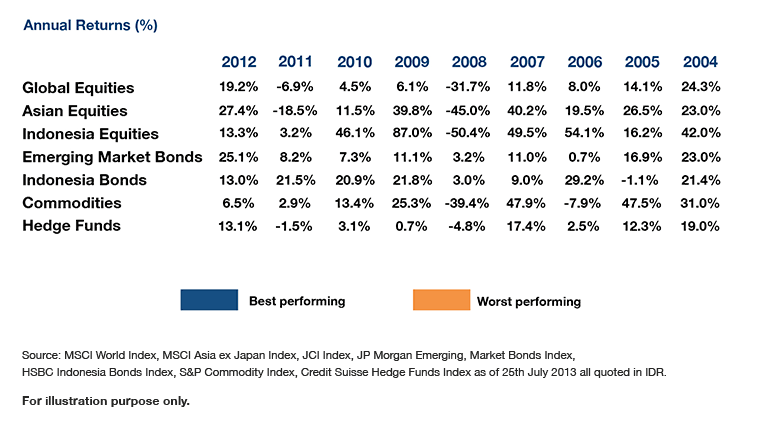What Is Diversification
Post on: 30 Апрель, 2015 No Comment

How to Diversify Your Investment Portfolio
Did you mean ?
Sign up
You can opt-out at any time.
Please refer to our privacy policy for contact information.
If you pay any attention to investing, you’ve heard the familiar chants about the importance of diversification in your portfolio. So what is diversification and how do you achieve it?
Diversification is spreading your money over different types of investments, instead of putting it all into one single stock or bond. One thing history has shown about the stock market: some investments move in different directions. When one goes up, the other goes down and vice versa. These are called non-correlated assets. Since no one knows when an investment will go up or down, you want to own non-correlated assets so some part of your portfolio is always growing, even when another part isn’t. This way you soften the jags in a volatile market, and even out your portfolio’s performance over time.
1. Allocate Your Assets
So how does one diversify? It starts with asset allocation. You divide your investment portfolio into different parts, such as stocks, bonds and cash. Stocks provide growth, bonds produce income with less risk and cash, or cash investments like CDs or money market accounts. offer a degree of safety and liquidity (although inflation is always a risk to cash holdings).
Financial experts recommend spreading investments across a mix of stocks, bonds and cash investmentsor stock funds, bond funds and money market or stable value funds. But how much should go to stocks vs. bonds is a very personal question. There is one trick that involves subtracting your age from 100, investing your age in stocks and the remainder in bonds. But an aggressive 25-year-old investor probably doesnt want 25% of their growth potential moving into the relative safety of bonds. And some young 50-somethings may not ready to move half of their nest egg into bonds. Although if you have built up a lot of assets, bonds can help to keep the principal safe and generate pretty good income See? It just depends. You really have to evaluate your own time horizon, goals and risk tolerance to come up with an allocation you can live with. There are plenty of resources on the Web to help, like risk tolerance quizzes and portfolio allocation tools.
There are other asset classes, such as real estate, commodities or private equity. As you become a more experienced investor, you may move a small portion of your portfolio into these asset classes. In fact, REITS or Real Estate Investment Trusts are among the most popular 401(k) investment types. They are non-correlated to other types of investments, and can be good income producers. Before you make any investment, make sure you understand the risks as well as the returns. The more exotic asset classes often have some tricky tax consequences as well. More
2. Look for Mutual Funds and ETFs
You can further diversify your holdings by forgoing individual stocks and bonds in favor of mutual funds. A mutual fund is a collection of investments, so when you buy a share of a mutual fund, you buy a wide array of stocks, bonds or whatever underlying investment the fund holds. A mutual fund or ETF investors success in the market does not depend on one companys good fortune.
Exchange traded funds or ETFs. are like mutual funds but they trade like stocks. With a single ETF share, you can buy into the growth of a group of companies. Most ETFs are passively managed or index funds. meaning they mirror the performance of a broad market index like the S&P 500. More
3. Consider Different Aspects of an Asset Class
Mutual funds and ETFs also often have strategies, areas of the market that they target. The funds you choose can help you divide your investments even more. For example, you can divide the stocks portion of your portfolio into domestic stocks, internationals stocks, large-company stocks and small-company stocks. You could have some money in growth stocks and some in income stocks (those that pay dividends), or a combination of the two. You can invest in a specific market sector, like energy or technology or retail. In short, there are many ways to skin a stock market. Bonds, too, come in many types. Treasury, corporate, municipal, high-yield, stable value, and more.
Or you could take a more minimalist route and use one to three broad market index funds to build your portfolio: a broad stock market index fund and a broad bond market index fund can give you plenty of diversification, and youll pay less in fees. If that seems like too much work, a target-date or lifecycle fund does the work for you. You can buy one with a built in asset allocation that adjusts as you near retirement age. You dont even have to think about it.
However you choose to diversify, it’s better than having your savings in a single stock position. Sort of. There’s a saying: Concentration creates wealth, diversification keeps it. And it’s true for some people, like Apple employees maybe, having a large concentration in one stock really works out. But for others, like employees of Enron, who also once had their life savings in high-flying stock, before it crashed and burned completely. If you have company stock, great. Work with a financial advisor or broker to build a diversified portfolio around it. More














